
If “exotic” and “novelty” are what draws consumers, the 2010 results of the prestigious Les Exceptionnelles contest will not disappoint them. And this year’s winning plants reflect the growing interest of gardeners for ornamental foliage.
If “exotic” and “novelty” are what draws consumers, the 2010 results of
the prestigious Les Exceptionnelles contest will not disappoint them.
And this year’s winning plants reflect the growing interest of
gardeners for ornamental foliage.
More than 3,100 visitors contributed to the selection of the 2010
Exceptionnelles at the Jardin Daniel A. Séguin of Saint-Hyacinthe’s
Institut de technologie agroalimentaire (ITA) campus. This attendance
record represents a 25 per cent increase over last year.
In 2009, the program’s success was such that the Montreal Botanical
Garden and the Jardin Roger Van den Hende of Laval University (Quebec
City) decided to become partners with the Jardin Daniel A. Séguin.
This new partnership adds the expertise of two of Quebec’s most
renowned gardens to the selection of winners. It also provides Les
Exceptionnelles with greater public awareness. The brands now benefit
from the credibility of the province’s three best-known educational
gardens. The 2010 selections are the result of this partnership.
The public voted overwhelmingly for three especially large plants that
made this year’s list. These plants performed consistently well
throughout the growing season. They were also the pick of the experts
from the three educational gardens and of industry members working in
production and marketing.
The final selection is always the result of a consensus within a
committee of experts, who validate consumer choices. The committee
considers ease of care, availability, quality and durability in the
test plots. Those selected are always new plants, chosen for their
capability of offering consumers an exciting and satisfying experience.
Les Exceptionnelles are a lot more than a selection of the year’s best
new plants. They are a group of top performing varieties that deserve
more space at retail. A true “exceptionnelle” variety must survive the
test of time. If not, it doesn’t deserve the recognition provided by
this brand. Therefore, Les Exceptionnelles are also good value for the
future. The 2010 winners are:
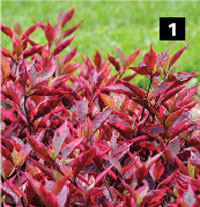
|
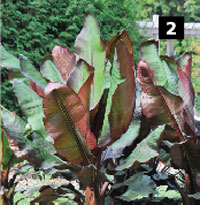
|
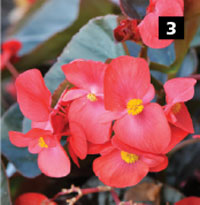
|
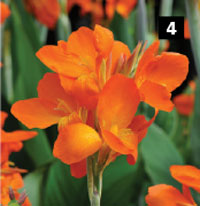 |
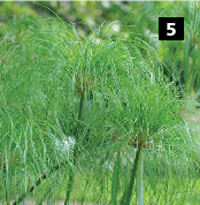
|
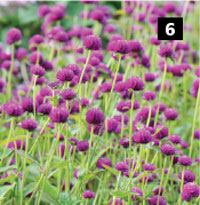
|
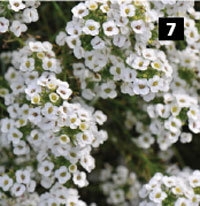
|
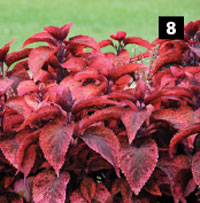
|
| Alternanthera brasiliana ‘Brazilian Red Hots’ (Photo One) | |
| • | Height: 15 – 30 cm |
| • | Width: 45 – 75 cm |
| • | Exposure: sun or partial shade |
| • | Ground spacing: 25 cm |
| • | Use: Alone in containers, or in flower bed combinations. |
|
This very popular plant demonstrates the public’s craze for varieties with leaves that stand out. Its leaves are purple and pink, offering great decorative qualities. The plant’s more or less irregular shape gives movement to arrangements, in pots or in the garden. This versatile plant loves heat. It may be grown in pots or in the garden. We recommend making it available to consumers in the 12-cm format. |
|
| Red Banana (Photo Two) | |
| • | Height: 150 – 200 cm |
| • | Width: 100 – 120 cm |
| • | Exposure: sun or partial shade |
| • | Ground spacing: isolated or spaced at 90 cm |
| • | Use: focal point in pot or in flowerbed. |
|
The ‘Maurelli’ banana tree is a tropical plant with giant leaves. It brings a touch of exoticism to the garden or the patio. It fits perfectly in the new trend of using tropical plants in landscaping. Its glossy leaves, with hints of purple on top and reddish below, are accentuated by a highly decorative red central nerve. This stocky banana tree grows very fast when heat settles in. It needs a warm spot and plenty of water to reach its full potential. Trials in Montreal and in Saint-Hyacinthe showed that the leaves are not damaged by wind. We recommend making it available to consumers in pots of one gallon or more. |
|
| Benary’s Begonia Big™ Red with Bronze Leaf Hybrid (Photo Three) | |
| • | Height: 30 – 50 cm |
| • | Width: 60 cm |
| • | Exposure: sun or partial shade |
| • | Ground spacing: 30 – 40 cm |
| • | Use: in container alone or in combination, in flowerbed, also perfect for large landscaping projects or parks. |
|
Benary has decided to launch a new variety of begonia bearing the company’s name, commemorating the 100th anniversary of the “Primadonna,” the very first hybrid begonia it put on the market back in 1909. This variety is not to be mistaken for the semperflorens variety. Even though its leaves are similar, the Big™ blossoms in a much more spectacular way. This variety has bronze-coloured leaves. The plant is appreciated for |
|
Orange Punch Canna Lily (Photo Four) |
|
| • | Height: 100 – 140 cm |
| • | Width: 45 – 65 cm |
| • | Exposure: sun or soft shade |
| • | Ground spacing: 80 – 90 cm |
| • | Use: focal point in pot or in flowerbed. |
|
The Orange Punch Canna Lily bears its name very well, because of its flower’s flaming colour. Grown from young plants from in vitro culture, it has the advantage of being exempt of the virus that affects a great part of cannas on the market. This versatile canna is of medium height. It blossoms all summer |
|
| Egyptian Papyrus Graceful Grass™ ‘King Tut®’ (Photo Five) | |
| • | Height: 120 – 175 cm |
| • | Width: 100 cm |
| • | Exposure: sun or soft shade |
| • | Ground spacing: 90 – 120 cm |
| • | Use: in pot as focal point, in flower bed or lining a water garden. |
|
A gracious papyrus that will become the king of the garden – even without a water surface. This variety grows very well in a pot or in a well-watered ground. Its jade green leaves form a firework effect, hanging on long sturdy stems. This plant brings an unequalled touch of exoticism to the garden. We suggest to market in pots of one gallon or more. |
|
Gomphrena globosa ‘Las Vegas Purple’ (Photo Six) |
|
| • | Height: 40 – 55 cm |
| • | Width: 30 – 40 cm |
| • | Exposure: sun |
| • | Ground spacing: 25 cm |
| • | Use: in container alone or in combination, in flower bed or as cut flowers (small bunch). |
|
This bright-coloured gomphrena has a good resistance to heat and drought. In the summer of 2009, it was among the most popular at the Jardin Daniel A. Séguin and the Jardin Roger Van den Hende. It opens up very well naturally, attracting hummingbirds and butterflies. It may be used as cut flowers in small, pretty bunches. This flower is rarely affected by insects and diseases. We recommend marketing it in pots of 10 to 12 centimetres. |
|
Lobularia Snow Princess™ (Photo Seven) |
|
| • | Height: 15 – 30 cm |
| • | Width: 30 – 60 cm |
| • | Exposure: sun or semi-shade |
| • | Ground spacing: 25 cm |
| • | Use: in container alone or in combination with aggressive plants in a flowerbed or hanging basket. |
|
This alyssum bred from cuttings is so vigorous that it doesn’t compare with traditional ground cover plants from seeds. One must try it at least once to experience the difference of this incredibly improved genetic. This robust plant likes cool temperatures. It quickly forms a carpet of strong-smelling white flowers that will last until October. It is to be used alone, or with very aggressive or high plants, because it can easily invade its neighbours. We recommend using pots of 10 centimetres or more, or in hanging baskets of 30 centimetres or more. |
|
Coleus ‘Mariposa’™ (Photo Eight) |
|
| • | Height: 60 – 90 cm |
| • | Width: 40 – 75 cm |
| • | Exposure: sun or semi-shade |
| • | Ground spacing: 45 cm |
| • | Use: in container alone or in combination, in flowerbed or as annual hedge. |
|
This is a coleus variety that is fully resistant to sunny conditions. ‘Mariposa’ is a variety with large leaves with a central part displaying a nice mix of crimson and purple, lined with a dark pink that becomes paler with time. The effect is highly decorative, which explains its great popularity. Grown under direct sunlight, this tough plant develops sturdy and regular stems that don’t break and make it possible to use as an annual hedge. Pots of 10 to 15 centimetres are suitable for this coleus grown from high-value cuttings. |
|
Les Exceptionnelles® is now officially registered as a brand that is
the exclusive ownership of the Fondation en horticulture ornementale de
l’ITA (Institut de technologie agroalimentaire) of Saint-Hyacinthe.
This not-for-profit organization’s goal is to allow the development of
the Jardin Daniel A. Séguin, in partnership with the community and the
industry, and to support the expansion of ornamental horticultural
knowledge in Quebec.
Horticolor Canada was chosen by the Foundation to develop the program’s
image and to provide the industry with proper marketing tool in points
of sale (posters, tags, table ribbons, charts, flyers, etc.) in order
to draw the consumer to the brand. The program’s visual signature will
now use an apple green Adirondack chair, a symbol of relaxation,
contemplation and joie de vivre.
Les Exceptionnelles is possible thanks to the following partners:
Passion Jardins, Botanix, Ball Horticulture, JVK, Norseco, Fafard,
Fleurs plantes jardins, FIHOQ, Horticolor Canada, IQDHO, Plant-Prod
Québec, Fernand Corbeil produits horticoles, Déco Style, Compostage GL,
Savaria and ITA, the Montreal Botanical Garden, and the Jardin Van den
Hende.
This is an adaptation of a feature by Claude Vallée, agr. M.S.,
professor of horticulture and coordinator of technological innovation
at ITA-campus Saint-Hyacinthe, claude.vallee@mapaq.gouv.qc.ca.
Print this page